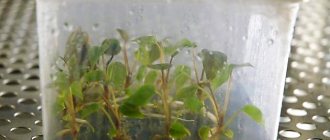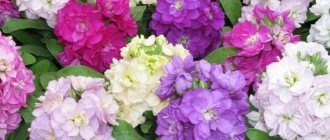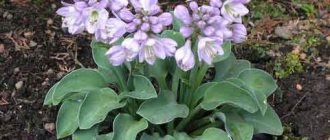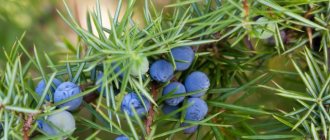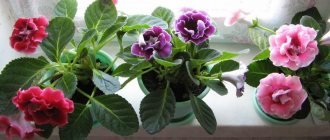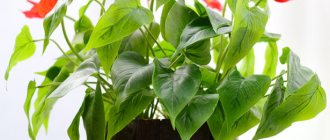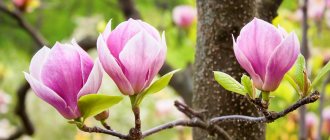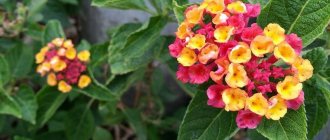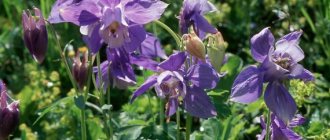Advantages and disadvantages of the method
The advantages of growing a flower at home from seeds include the fact that this is the only propagation method that allows you to grow more than a dozen plants at the same time. For those who want to try themselves as a breeder, this method is more suitable than others, since the grown plant will most likely be different from the “parent”.
One of the disadvantages is that this method of cultivation will be associated with certain difficulties. For example, you will have to pollinate a flower to obtain seeds yourself, and the characteristics of the plant being grown may be unpredictable. Anthurium seed material has a short shelf life - less than 6 months; there is no point in planting after it has expired.
Reference. Seed propagation is suitable for varietal anthurium species; for hybrids it is better to use vegetative methods.
Time for breeding at home
The most optimal time of year for planting seeds (as well as for other propagation methods) is spring, namely the period from mid-April to mid-May. Planting at the beginning of summer is also considered acceptable.
Planting in winter is undesirable, however, it will be effective with proper care. For winter sowing, it is better to choose the second half of February. Sprouts need to be provided with an ambient temperature of at least 22-25 degrees Celsius and additional lighting.
Selection of capacity
Anthurium has a shallow root system, so a shallow and wide container is well suited for it. It is better to use a pot made from natural materials, such as clay. The plant will feel more comfortable in such dishes than in plastic ones.
- Anthurium seeds are first sown in small containers, which are then covered with film for seed germination.
- Then, 1-2 weeks after germination, the plant along with the soil is transplanted into a larger pot.
If you immediately use too large a container for seeds, the plant will develop much more slowly.
Preparation
To propagate the plant you will need:
- containers with holes in the bottom;
- substrate for planting;
- drainage;
- "Epin", "Kornevin" or "Heteroauxin";
- a sharp knife sterilized with potassium permanganate or alcohol;
- sharpened wooden stick.
To root a divided bush, you will need small wide containers and soil in which adult anthuriums are grown with the addition of perlite, coconut fiber or sphagnum moss. The seeds are sown in the same substrate, only the amount of baking powder is increased. Cuttings are planted in perlite or sphagnum.
Plant anthurium cuttings or divisions in plastic or plastic containers. If you don’t want unpresentable containers to spoil the interior, place them in a decorative flowerpot or a beautiful larger pot, and fill the free space with damp sphagnum or acidic peat.
Working with seed material
Seed material can be obtained either independently (through the procedure of flower pollination) or purchased ready-made.
Reference. Healthy seeds of the plant are small in size, have an oblong-rounded shape, fresh - orange-brown, dried - dark brown.
We get it ourselves
It is strongly recommended to wear gloves when working with fruits and seeds, as direct contact with skin can cause irritation or allergies.
- To obtain seeds, the flower must be pollinated by hand, choosing a sunny day for this. You will need at least two plants.
- Next you need to prepare a small soft brush.
- Using a brush, you need to collect pollen from the inflorescence of one plant and transfer it to the inflorescence of the second.
- The pollination process is repeated for 5-7 days.
- Fruit ripening occurs in 10-12 months.
- Ripe berries are removed and the shell is removed.
- The resulting seeds must be dried in the open air (no more than 1-2 days), and then prepared for planting.
Photo
And here’s what anthurium seeds look like in the photo
Purchase from China
Reviews of anthurium seeds that were brought from China vary greatly. Some consider such a purchase risky, as they have encountered dishonest sellers who passed off seeds of another plant as anthurium, or gave false information about the time of collecting seeds. However, there are relatively few such reviews.
When ordering seed, your preference should be given to trusted sellers with a good reputation (you can find out about it from customer reviews). Next, you need to contact the supplier and inquire about the quality of the seeds, the characteristics of the selected variety and the timing of collection.
Attention! It must be remembered that anthurium seed does not retain its viability for long, so you should only purchase seeds that have been collected recently.
Preliminary processing
Immediately before planting, the seeds should be soaked in a weak solution of potassium permanganate for 15 minutes, then placed on a napkin or soft cloth to remove excess moisture. This procedure is necessary to disinfect the seed material.
Direct sowing of seeds
Anthuriums should be sown in spacious but shallow containers. Prepare the substrate yourself or buy it at the store. The main requirement for it is very simple - it must be loose, light, retain moisture well and be saturated with oxygen. It would be nice if you fry it in the microwave or treat it with boiling water 2–3 days before sowing.
The simplest substrate option is peat, river sand and light leaf soil, mixed in equal proportions. Instead of sand, it is good to use perlite, and also add finely chopped sphagnum moss.
- – fill the container with the prepared mixture;
- – compact the mixture, moisten it (preferably with the addition of slightly pink potassium permanganate);
- – scatter the seeds on top, trying to do it as evenly as possible;
- – lightly press the seeds into the ground (for example, with a spoon), but do not deepen them;
- – cover the container with glass or transparent film to prevent the substrate from drying out quickly;
- – place the improvised greenhouse in a bright place with a temperature of about 22 °C (ideally).
The warmer the surrounding air, the faster germination will occur, but the likelihood of seed rotting will also increase. At the temperature indicated above, the first shoots appear after 5 - 7 days, but mass germination is observed after about 2 weeks. If the air was too cold, the seedlings germinate only after a month, and many of them die.
Important! During germination, make sure that the greenhouse is not too humid and do not allow the substrate to become wet. To do this, ventilate your “bed” daily.
How to plant correctly?
- You need to pour the substrate prepared in advance into the container, water it and let the water absorb.
- Distribute the seeds over the surface of the soil, sprinkle a little on top.
- Cover the container with polyethylene or glass.
- It is important to provide future plants with bottom heating and bright lighting. The room temperature should be at least 25 degrees.
- Every day you need to open the container with seeds for ventilation for 7-10 minutes.
- As the soil dries, it is necessary to spray it with water.
- The first shoots can be seen a week after planting the seeds, the main ones - after 10-15 days. At the stage of formation of the first true leaf, the polyethylene (glass) can be removed.
- Next, the anthurium can be transplanted into a pot (in addition to the soil, the pot must have drainage, for example, from crushed stone or river sand).
Anthurium can be propagated by other methods:
- leaf;
- cuttings;
- lateral shoots (shoots);
- planting a bush.
Read about these methods on our website.
Aftercare
The plant prefers warm and humid air, but it should be protected from scorching sunlight. Before flowering, the anthurium is fertilized monthly with complex mineral fertilizer (preferably for flowering plants).
Watering is done regularly, about 2-3 times a week. The soil should not be allowed to dry out. It will not be superfluous to periodically spray the foliage of the plant with water at room temperature.
If you place sphagnum moss near the base of the stem, moisture in the soil will remain longer.
Anthurium andre
The most common among anthuriums. It has won the hearts of many gardeners, as it blooms beautifully almost all 12 months of the year. Flowers of amazing beauty are located on long peduncles. Their color is varied.
There are specimens with red, white, lilac, pink, and dark burgundy flowers. Breeders managed to develop varieties with green and black bracts. To be precise, it is not the flower that is considered expressive in the anthurium, but the cover, next to which the flower is located on the cob.
When the flowering period ends, the bright blanket turns into a green leaf.
If “Male Happiness” Doesn’t Take Well
- Cold. If the room temperature drops below 16 degrees, this can negatively affect the tropical plant. You need to take care of a warmer growing room.
- Lack of moisture in the air. Dry air can also cause the anthurium to deteriorate - this problem can be solved by spraying the leaves and air around the plant.
- Drafts, as well as sudden temperature changes, negatively affect anthurium.
- Violation of the watering regime. Too frequent or, conversely, insufficient watering can destroy the plant. Anthuriums need to be watered regularly and moderately.
- Pests can cause the death of a flower. It is important to treat against parasites once every 2 months, and also as needed.
- Lack of light will cause the plant to wilt, and exposure to direct sunlight will cause it to dry out. It is important to maintain a healthy balance of lighting.
- Non-nutrient soil. Anthurium, like many other indoor plants, needs regular additional feeding; it should not be neglected.
The homeland of anthurium is the tropics, which is what causes some difficulty in caring for the plant for residents of temperate and northern latitudes. However, this does not stop flower growers, impressed by the exotic beauty of the capricious flower. It has become popular both for gardening, greenhouse and indoor cultivation in many countries around the world. With proper, conscientious care, anthurium will delight its owner with long-lasting and vibrant flowering. Now you know how to plant seeds and grow “Male Happiness” from them.
If you find an error, please select a piece of text and press Ctrl+Enter.
Possible problems when growing anthurium
It happens that the plant suffers from rot. To prevent disease, you need to add water moderately and maintain an optimal level of humidity in the room. If not properly cared for, anthurium will develop anthracnose.
The disease manifests itself as drying out of the leaf blade (in the beginning it is affected only at the edges). A plant kept at home may not produce flowers. A common cause of the problem is pest infestation.
Anthurium turns yellow if the root system rots. In this case, you need to carefully remove the plant and remove the damaged parts. In the future, you will need to normalize watering. If you add water too often, the ends of the leaves will turn dark.
Do not overuse any fertilizers, including those containing calcium. Possible causes of drying out:
- the flower received minerals in excess;
- on the contrary, it lacks mineral components;
- Anthurium receives a lot or little water.
In some cases, it is necessary to change the soil mixture. To restore the anthurium, you need to properly care for it in the future.
Reasons why leaves curl:
- low humidity levels;
- lack of lighting;
- being in drafts.
Anthurium may suffer from pests such as:
- scale insect;
- aphid;
- spider mite
We invite you to familiarize yourself with the cow pouted
